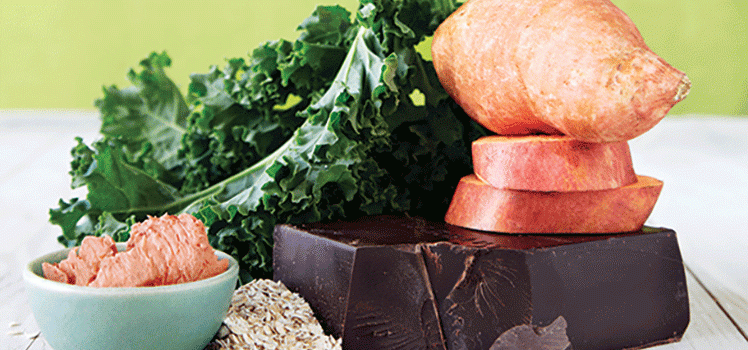It’s easy to improvise with your cooking and baking when you know how to swap one ingredient for another. Forgot to pick up something from the store? Substitutions let you work with what you’ve got in the pantry. Food swaps can also boost the nutritional value of a meal, let you switch to a budget-friendly option or simply liven up your usual recipes.
Some substitutions are just measure-for-measure exchanges: flavours, textures and nutritional values might change, but weights and volumes won’t. Other substitutions call for different ratios, cooking temperatures, methods or times. (Note: When making major swaps for dietary restrictions, we recommend looking for alternative recipes from a trusted source.)
While the idea of changing up tried-and-tested favourites can seem intimidating, it’s actually a lot of fun to experiment in the kitchen to see how different substitutions can yield inspiring results.
Our handy guide is your road map for making these switches work. Now you’ll be able to put together a delicious meal, no matter what’s in the pantry and fridge. The most important tip: Trust your taste buds and taste as you go!
Flavourings
- Instead of bittersweet chocolate, try semi-sweet. The two can be used interchangeably. Alternatively, add one tablespoon (15 millilitres) of sugar per one ounce (30 grams) of unsweetened baking chocolate.
- To replace chocolate chips, use chopped bar chocolate. Swap one for one by weight, and don’t worry about chopping even pieces. Sometimes, a mixture of textures makes for a more pleasing finished product.
- Out of chocolate? For each ounce (30 grams) of unsweetened baking chocolate, use a blend of three tablespoons (45 millilitres) of unsweetened cocoa powder and one tablespoon (15 millilitres) of vegetable oil, melted butter or shortening. For the best results in desserts and baked goods, use the highest-quality chocolate and cocoa powder you can find – you’ll taste the difference.
- Instead of one teaspoon (five millilitres) of dried herbs, use one tablespoon (15 millilitres) of fresh – or vice versa. When in season, fresh herbs can add a new dimension to your favourite dishes; when fresh herbs are out of season, dried herbs are generally more affordable and more available. These substitutions work better when texture is not an issue, such as in soups and stews. Fresh herbs are still preferred for garnishes.
Dairy
When replacing dairy, think about two main things: flavour and texture. Canned coconut milk, for example, will add a coconut taste, which may or may not be desirable. Substitutions should ideally be of similar consistency: Greek yogourt in place of full-fat sour cream generally works well, for instance, while using skim milk in a recipe that calls for full-fat milk may not get the intended results.
- To replace milk, try non-dairy milks such as soy, almond, rice, oat and coconut (in a carton). These alternative milks work well for tea, coffee, lattes, smoothies and hot chocolate and as a cup-for-cup replacement in pancakes and cakes. Some non-dairy milks can curdle when added cold to a hot beverage; to prevent this, try heating them in the microwave or on the stovetop before using, or let your drink cool slightly before adding the milk.
- As a substitute for cream or evaporated milk, try full-fat canned coconut milk. Its thick and creamy consistency is tasty in smoothies, on top of oatmeal, and in soups and curries.
- Instead of whipped cream, use full-fat canned coconut milk. Refrigerate at least eight hours or overnight, turn the can upside down and open without shaking, then pour out the liquid and whip up the solid component with one teaspoon (five millilitres) of vanilla extract or other desired flavourings. Bonus: Stored in the refrigerator, whipped coconut cream stays spreadable and meltable – perfect as an alternative to butter on top of pancakes or biscuits. It can also be the base for a dairy-free alternative to cream cheese frosting.
- Swap out buttermilk for a homemade version. Add one tablespoon (15 millilitres) of lemon juice or vinegar to one cup (250 millilitres) milk (dairy or non-dairy) to make a substitute that can be used in the same quantities and in the same ways. Another alternative is to thin out three-quarters of a cup (175 millilitres) of plain yogourt with a quarter cup (60 millilitres) of water or milk.
- Instead of sour cream, try yogourt. Greek or full-fat plain yogourt can act as a straight-up substitution for full-fat sour cream in most cooking and baking, or to serve with soups and other dishes. Depending on the recipe, you may have to thin out Greek yogourt, and keep in mind that the flavour will be slightly different.
Eggs
Eggs work in baking as a leavening agent (the ingredient that helps baked goods rise), a binding agent and a source of liquid. They can usually be replaced in recipes where eggs are not a primary ingredient. For example, substitutions will work in carrot cake, but not in angel food cake, which depends on beaten egg whites, nor in egg-based custards such as crème brûlée.
Instead of eggs, try:
- Ground flax or chia seeds. For baked goods such as cookies or muffins, try a mix of one part ground flaxseeds or chia seeds and three parts water, stirred together and then allowed to rest and gel for at least 15 minutes. For every large egg, use one-quarter cup (60 millilitres) of the replacement – about one tablespoon (15 millilitres) of seeds with three tablespoons (45 millilitres) of water. Keep in mind that this mixture, which serves as a binding agent, works better for denser recipes (cookies, pancakes or muffins) than for baked goods like cakes, which need to rise more.
- Yogourt or puréed silken tofu. Swap each large egg for one-quarter cup (60 millilitres) of the substitution. Tofu makes an especially good substitute for eggs and cream or evaporated milk in pumpkin pie filling.
- Baking soda mixed with white or apple cider vinegar. In baked goods where eggs would usually serve as a leavening agent, use one teaspoon (five millilitres) of baking soda mixed with one tablespoon (15 millilitres) of white or apple cider vinegar for each large egg.
Fats
- To replace vegetable oil in baking, use melted butter. As a one-for-one replacement (measured in its liquid form), butter can add rich flavour to dishes. You can also do the reverse, using vegetable oil instead of melted butter in recipes such as cornbread. Substituting vegetable oil for solid butter is not recommended in most cases, though it can work, especially in recipes with only a small amount of fat. Use olive oil in baking only when its flavour is desired, such as in a lemon-olive oil cake.
- Instead of softened butter, try the same amount of coconut oil in most baked goods. Ensure that the coconut oil is in its solid form; refrigerate before using if yours is liquid. Coconut oil can be used instead of butter in pie crust, too, but it’s best to seek out a recipe intended for coconut oil.
- To replace fat in baked goods, use purées of fruits or vegetables. Stewed apple, banana, carrot and squash purées help tenderize baked goods such as muffins and loaves. Substitute up to half the fat with one of these alternatives, but keep in mind this replacement will affect texture.
Flour
- Instead of wheat flour, use gluten-free flour blends. Wheat contains gluten, a naturally occurring protein that adds structure and elasticity to baked goods, which is why wheat flour can be challenging to substitute. In many recipes, you should be able to replace wheat flour, cup for cup, with an all-purpose gluten-free flour blend. However, to make the best use of the flavours and textures of alternative flours, opt for recipes that were developed specifically as gluten-free.
- To replace white or all-purpose flour, use a blend of whole wheat and white. Unlike white flour, whole-wheat flour contains the bran and germ of the grain, making it heavier and denser. The heartier the recipe and the less rising required, the better whole-wheat flour will work. Substitute between one-third and one-half of the white flour with whole-wheat flour, and let the dough or batter rest for at least 10 minutes before baking so that the flour can fully hydrate.
- Instead of wheat flour, try almond flour. This rich-tasting (and gluten-free) alternative works particularly well in cakes, where its nuttiness adds a flavour boost. Substitute up to one-third of the all-purpose flour with almond flour (also known as almond meal). The results will differ from the original recipe, but you may find that you love the new variation even more!
- To replace cake flour, use all-purpose flour blended with cornstarch. Cake flour helps make baked goods more tender because of its lower protein content. For each cup (250 millilitres) of cake flour, remove two tablespoons (30 millilitres) from one cup (250 millilitres) of all-purpose flour and replace with two tablespoons (30 millilitres) of cornstarch. Sift together well before using.
Sweeteners
- Instead of agave syrup, use maple syrup or liquid honey. These three liquid sweeteners can be substituted one for one, though keep in mind that maple syrup and honey have distinct flavours, whereas agave syrup has a more neutral taste.
- To replace coconut sugar, use brown or white sugar, and vice versa. In baking, they can be swapped cup for cup.
- Swap out white sugar for stevia, a sweetener derived from the leaf of the stevia plant. For every cup (250 millilitres) of sugar in your recipe, use one teaspoon (five millilitres) of liquid stevia; half a teaspoon (two millilitres) of stevia extract powder; one tablespoon (15 millilitres) of concentrated stevia liquid; or 18 to 24 individual serving packets, and adjust to taste. Since the volume of stevia that’s required is so much smaller than that of sugar, bulk up the batter with one-third cup (75 millilitres) of applesauce, egg white, fruit purée or yogourt.
Raising Agents
- Instead of self-rising flour, try this homemade substitute: For each cup (250 millilitres) of self-rising flour, use one cup (250 millilitres) of all-purpose flour, one and a half teaspoons (seven millilitres) of baking powder and one-quarter teaspoon (one millilitre) of salt.
- To replace baking powder, use this formula: For each teaspoon (five millilitres) that the recipe calls for, add a combination of half a teaspoon (two millilitres) of cream of tartar and one-quarter teaspoon (one millilitre) of baking soda.
Grains
Cooked grains are often interchangeable, whether in side dishes, in salads or served with stew or curry. Switching things up adds variety to your diet and gives fresh flavours to old standbys. Follow the cooking instructions on each package, or view our handy infographic on cooking grains for guidelines.
- Instead of rice, try quinoa, buckwheat, millet or amaranth. These alternative grains pair well with stews, curries, pilafs and saucy dishes. Count on about half a cup (125 millilitres) of cooked grain for each serving.
- Swap out pearl barley for pearl farro. It’s just as hearty in a soup or salad, with a shorter cooking time – just 30 minutes without presoaking, compared to the 50 to 60 minutes that pearl barley requires.
- Rather than oatmeal, try amaranth or teff for a fresh spin on porridge, with a nuttier flavour. Cooked amaranth tastes delicious with sautéed fruit, such as plums or bananas.
Meat
- Instead of chicken, try pork. These white meats can be used interchangeably in many dishes, as both have a mild flavour and work well with herbs such as rosemary, sage, thyme and Italian-style blends. In oven-baked dishes, switch chicken breasts for pork chops. In burgers or pasta sauces, swap ground chicken for ground pork, cup for cup.
- Rather than ground beef, use ground turkey. Turkey is an alternative that can be substituted in pasta sauces, chili and meatloaf. Just bear in mind that its flavour is less robust, so you may need to add extra herbs and spices to compensate.
Fish and Seafood
- Instead of halibut, try cod, tilapia, haddock or pollock. These white fish are also deliciously mild, tender and flaky yet firm, and they can make economical alternatives. Cooking time and temperature will not be affected, although you will notice subtle differences in texture and flavour.
- Swap canned tuna for canned salmon. These are interchangeable for sandwiches, although tuna has a richer, “meatier” flavour.
- Rather than raw fish, use smoked salmon or trout or canned salmon or tuna in sushi. For every six ounces (175 grams), moisten canned fish with about two tablespoons (30 millilitres) of mayonnaise.
- Replace clams with mussels. In recipes such as paella or seafood pasta, you can substitute different kinds of shellfish – mussels, clams, prawns – without otherwise changing the recipe.
Sauces
- Instead of Worcestershire sauce, try soy sauce. Soy sauce offers comparable salty fermented flavours without the anchovies present in Worcestershire. Add a few drops of Tabasco for heat and a pinch of ground cloves for spice.
- Rather than wheat flour as a thickener, try cornstarch or arrowroot. Use half the quantity of cornstarch (for thickening dairy-based liquids) or arrowroot flour (for thickening acidic liquids) in place of wheat flour.








